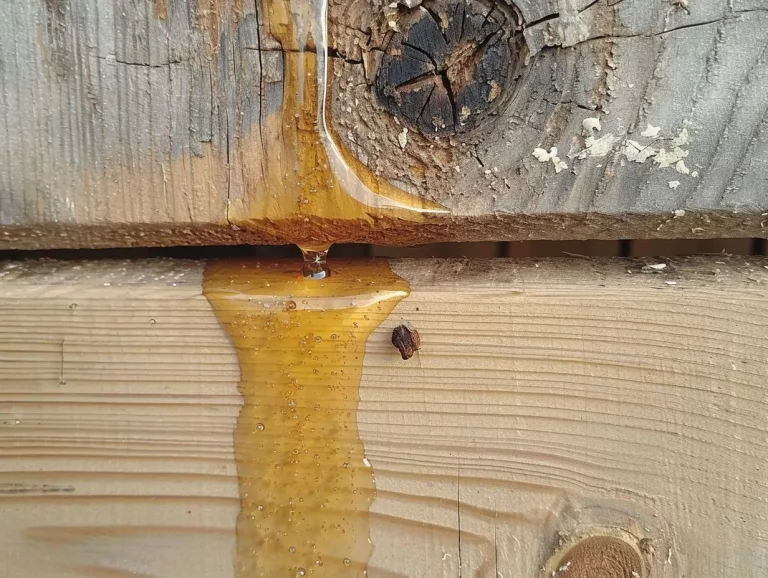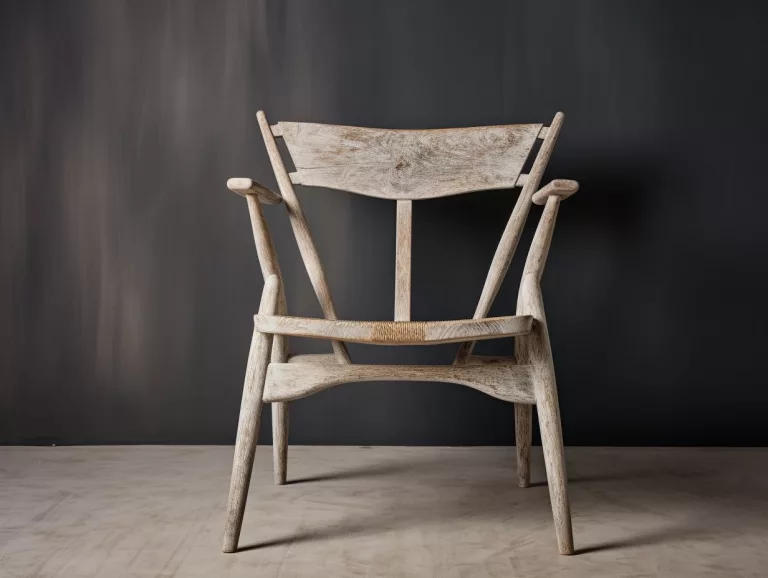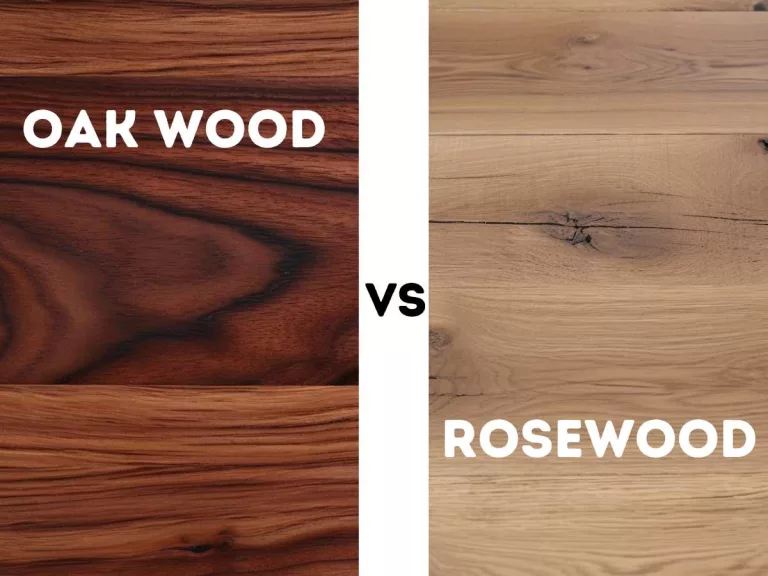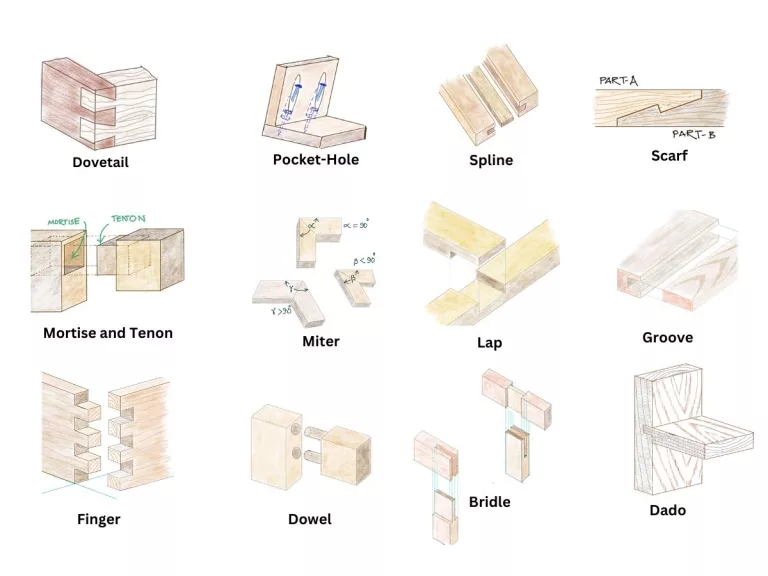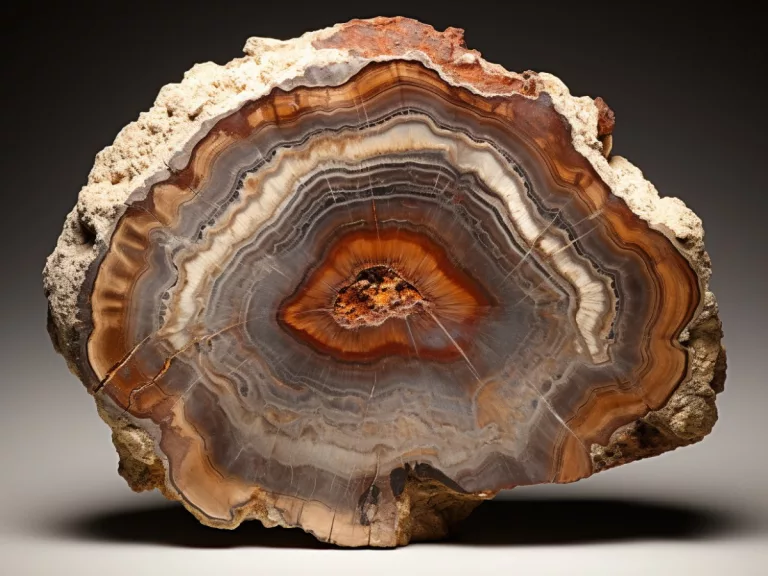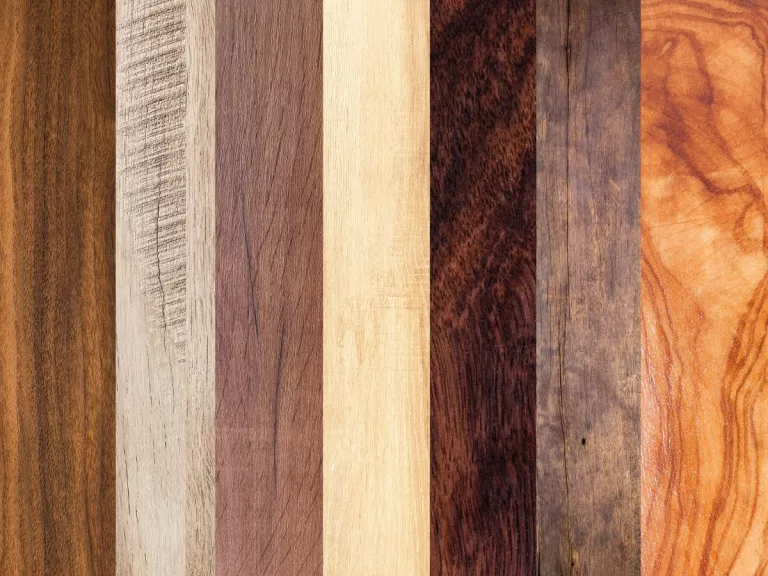How to Get Sap Off Wood Floor: A Comprehensive Cleaning Guide

Key Takeaways
Quick Action: Immediately address sap stains using gentle methods like the ice technique for fresh sap and natural cleaners for dried sap.
Floor Care: Determine your wood floor’s finish to select appropriate cleaning methods and perform regular maintenance to prevent damage.
Preventive Steps: Use mats, rugs, and the right Christmas tree stand to minimize sap exposure and protect your floors.
Expert Advice: Consult with flooring professionals for specialized care and explore additional resources for ongoing floor maintenance.
Hey there, fellow clean freaks and wood floor aficionados! Ever found yourself in a sticky situation, quite literally, with sap making its unwelcome mark on your beautiful wood floors? You’re not alone. But How to Get Sap Off Wood Floor?
Whether it’s a souvenir from your festive Christmas tree or an accidental import from outdoor adventures, sap on wood floors is a common headache for many. But fear not! Addressing this gooey guest promptly can save your floors from a sticky fate and keep them looking as gorgeous as the day they were installed. Let’s get into the nitty-gritty of sap’s world and how to show it the door, shall we?
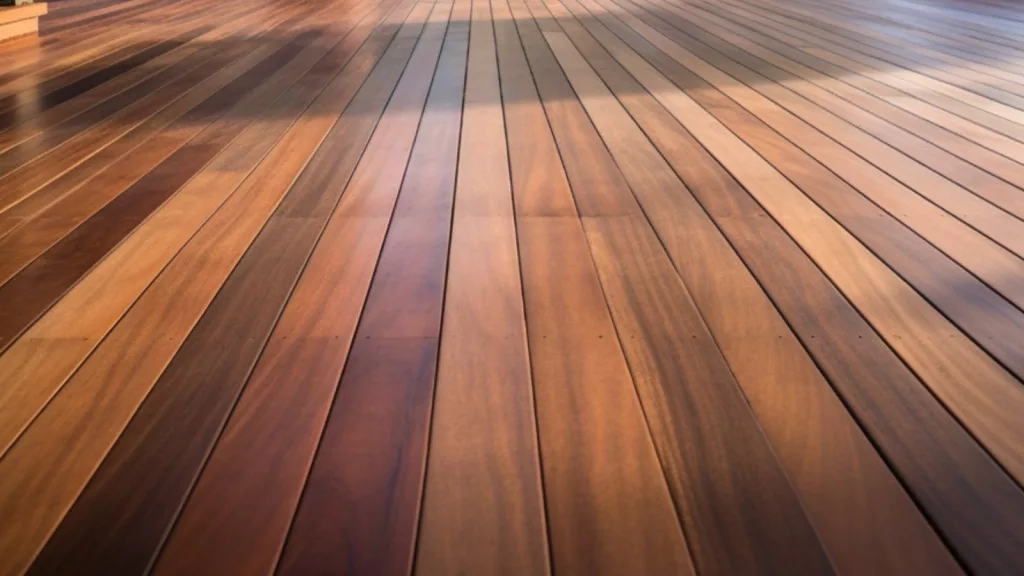
Sap and Its Impact on Wood Floors
What Is Sap?
So, what’s this sticky adversary we’re battling? Sap, my friends, is the lifeblood of trees. It’s packed with water and nutrients, cruising through the tree’s veins. When it kisses your wood floors, though, it becomes less of a life force and more of a stubborn stain. Why does it stick, you ask? Well, sap is designed to be sticky to protect trees from invaders (think insects and diseases), but when it lands on your floor, it sees no difference, clinging on for dear life.
The Consequences of Ignoring Sap
Ignoring sap can escalate into more significant damage over time, much like a small, unchecked leak in a roof. It can cause the following damages.
- Sap Attracts Dirt: Left untreated, sap acts like a magnet for dirt, compromising the cleanliness and appearance of your wood floors.
- Potential for Damage: Over time, sap can seep into the wood, leading to discoloration and irreversible damage.
- Dulls Floor Shine: Sap can strip away the natural shine of your wood floors, leaving them looking dull and lifeless.
- Silent Floor Killer: Without prompt and proper care, sap can gradually degrade the beauty and integrity of your wood floors.
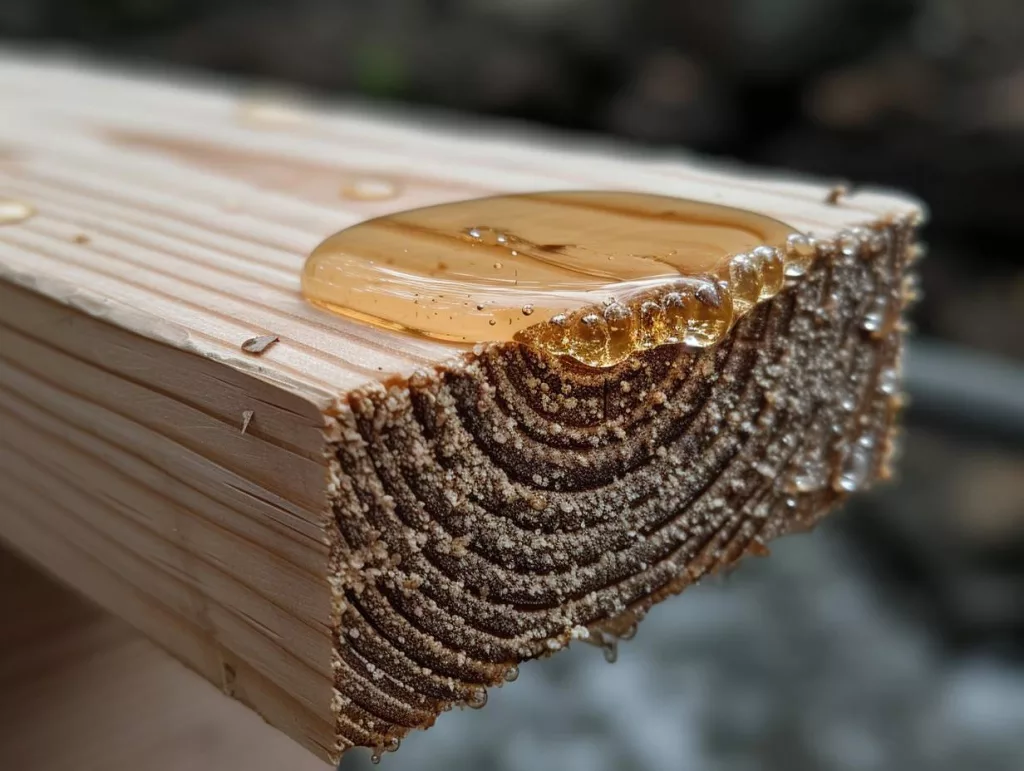
Preparing to Clean
Before you dive into battle, let’s gear up properly. Cleaning sap off wood floors isn’t just about elbow grease; it’s about smart, safe cleaning practices.
Select Non-Damaging Cleaning Supplies
The first rule of Fight Club—err, sap cleaning—is: do no harm. Choose your cleaning weapons wisely. Harsh chemicals and abrasive tools are out. Gentle, wood-friendly cleaners and soft cloths are in. Think of it as performing delicate surgery on your precious floors.
Identifying Your Wood Floor’s Finish
Not all wood floors are created equal. Some are sealed with polyurethane, others with wax, and some with oil. Knowing your floor’s finish is like knowing your enemy; it dictates your strategy. A quick test in an inconspicuous area can reveal a lot. For polyurethane, water beads up; for oil or wax, it soaks in. Choose your cleaning method accordingly to avoid turning your cleaning mission into a renovation project.
Guide to Removing Sap from Wood Floors
Removing sap doesn’t have to be a chore worthy of a Greek tragedy. With the right approach, you can restore your floors to their former glory. Whether you’re dealing with a fresh spill or a hardened glob, I’ve got you covered.
Addressing Fresh Sap Stains
Caught the sap before it’s settled in for a long winter’s nap? Perfect timing! Fresh sap is easier to deal with, and here’s how you can show it the door:
Ice Technique: Hardening the Sap for Easier Removal
- Grab a handful of ice cubes from the freezer.
- Place the ice cubes in a plastic bag.
- Lay the chilly pack on the sap for about 15 minutes.
- The goal is to harden the sap, making it less sticky and more brittle for easier removal.
- Think of it like turning the sap into a frozen villain in a superhero movie, immobilized and ready to be defeated.
Gentle Scraping: Avoid Floor Damage
- Once the sap has hardened, use a plastic scraper, credit card, or the edge of a spoon.
- Carefully lift the sap off the floor.
- Apply gentle pressure, as if coaxing the sap away, rather than using force.
- Think of it as a delicate approach to sap removal, ensuring your floor remains unharmed and appreciates your finesse.
You can check this video instruction.
Tackling Dried or Hardened Sap
If the sap has already settled in, fear not. It’s not invincible; it just requires a bit more strategy to defeat.
Natural Cleaning Solutions
Olive Oil Method
Olive oil isn’t just for salads anymore. Apply a small amount of olive oil to a cloth and gently rub it on the sap. The oil works to soften the sap, making it easier to wipe away. Plus, your floor gets a nice, albeit unintentional, polish in the process.
Homemade Sap Remover with Vinegar
Mix equal parts vinegar and warm water in a spray bottle. Spritz it on the sap, let it sit for a few minutes, then wipe away with a soft cloth. Vinegar’s natural acidity helps break down the sap, freeing your floor from its sticky grasp.
Using Commercial Cleaners Safely
Guidelines for Selecting and Applying Commercial Sap Removers
When natural methods don’t cut it, it might be time to bring in the reinforcements. Choose a cleaner designed for use on wood floors and test it in an inconspicuous area first. Apply the cleaner according to the instructions, using a soft cloth to gently work away the sap. Remember, the goal is to remove the sap, not the floor’s finish, so proceed with care.
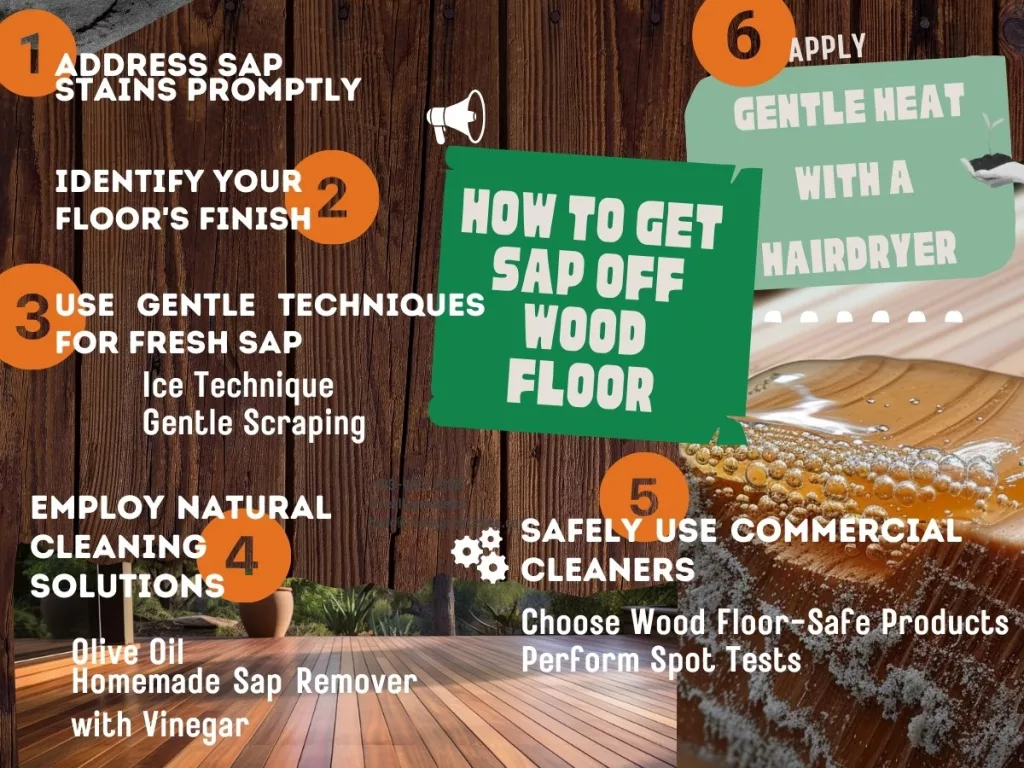
Preventive Measures
Protecting your wood floors from sap isn’t just about cleaning up after the fact; it’s about taking proactive steps to prevent damage before it starts. Here’s how you can keep your floors looking pristine.
Regular Floor Maintenance Tips
Keeping your wood floors in top shape requires a little love and attention. Here are some strategies to incorporate into your daily and weekly routines:
- Daily Dusting: Use a microfiber mop or cloth to pick up dust and dirt. It’s like giving your floors a gentle hug every day, keeping them clean and preventing abrasive particles from scratching the surface.
- Weekly Cleaning: With a wood floor cleaner recommended by your floor’s manufacturer, give your floors a more thorough clean. Think of it as a spa day for your floors, leaving them refreshed and rejuvenated.
- Immediate Spill Cleanup: Act fast on spills, including water, to prevent them from seeping into the wood and causing damage. It’s like dodging a bullet in slow motion – the quicker you are, the less damage done.
Implementing Protective Measures
An ounce of prevention is worth a pound of cure, especially when it comes to protecting your wood floors from sap and other potential hazards.
- Mats and Rugs: Place them at entrances and high-traffic areas to catch dirt and debris that could scratch your floors. It’s like setting up a security checkpoint to stop floor-damaging culprits in their tracks.
- Floor Sealants: Consider applying a sealant to add an extra layer of protection against spills and stains. It’s like giving your floors an invisible shield, ready to defend against any invaders.
Selecting the Right Christmas Tree Stand
Choosing the right stand for your Christmas tree can significantly reduce the risk of sap drips.
- Look for Stands with Sap Catchers: Some stands are designed with built-in sap catchers to prevent drips from reaching your floor. It’s like having a built-in bodyguard for your floors, ready to catch any sap that tries to sneak past.
- Stability is Key: A stable stand reduces the risk of your tree tipping over and causing a sap disaster. It’s the foundation of sap prevention during the holiday season.

Pro Tip #1: Gentle Heat: Use a hairdryer on a low setting to soften dried sap, making it easier to remove without damaging the floor.
Pro Tip #2: Extra Finish: Apply an extra layer of finish to your wood floors for added protection, making sap removal more manageable and enhancing durability.
Expert Advice
Gathering wisdom from those who’ve spent years in the trenches of wood floor care can provide invaluable insights into protecting and maintaining your floors.
I’ve reached out to several flooring professionals to get their take on dealing with sap. Here’s what they had to say:
- Quote from a Flooring Expert: “The best defense against sap is a good offense. Regular cleaning and the right protective measures can make all the difference.” It’s like having a game plan that keeps your floors safe and sound.
Professional Recommendations
Based on conversations with experts, here are some top tips for specialized wood floor care and sap removal:
- Immediate Attention: Don’t let sap sit on your floors for too long. Acting quickly can prevent it from setting and causing more significant issues.
- Professional Cleaning Solutions: For tough sap stains, consider products specifically designed for wood floors. It’s like choosing the right tool for the job, ensuring your floors get the care they need without the risk of damage.
You can follow this table, and find the suitable one for the sap stains.
| Method | Description | Advantages | Disadvantages |
|---|---|---|---|
| Turpentine | A solvent great for dissolving sap, requiring safety gloves and good ventilation. | Effective at dissolving sap; widely available. | Toxic and flammable; requires caution. |
| Mineral Spirits | Effective in removing sap, highly flammable, and may require testing on a small area first. | Readily available; can remove various stains. | Flammable; harmful fumes; may harm some finishes. |
| Goo Gone | Adhesive remover that works on various surfaces, including wood, for sticky residues. | Instantly removes sticky residues; surface safe. | Specific product needed; may require purchase. |
| Murphy Oil Soap | Oil soap used for cleaning sap off decks, apply undiluted and scrub after letting it sit. | Effective for penetrating deck sealant; easy application. | Requires stiff-bristle brush for scrubbing; might need rinsing. |
| Heat Application | Softens sap for easier removal using a heat gun or hair dryer, avoiding harsh chemicals. | Environmentally friendly; minimal risk to wood. | Requires specific tools; risk of overheating wood. |
| Soap Solution | Mild, effective in removing sap with the aid of hot water to soften the sap before scrubbing. | Safe on finished and unfinished wood; easily accessible materials. | May not be as effective on hardened |
Common Mistakes to Avoid
When it comes to sap removal, a little misstep can lead to a bigger mess. Here’s what not to do:
- Don’t Reach for Harsh Chemicals First: It might be tempting to use a strong cleaner to tackle sap, but harsh chemicals can damage the finish of your wood floors. Stick to gentler methods first.
- Avoid Scratching the Surface: Using a metal knife or other sharp objects to scrape off sap can leave unsightly scratches. Opt for a plastic scraper or a credit card edge for a safer alternative.
- Skipping the Spot Test: Before using any cleaner, even those labeled as “wood-safe,” do a spot test in an inconspicuous area. Better safe than sorry!
Additional Resources
For those hungry for more knowledge or the perfect product to add to their cleaning arsenal, here are some resources to explore:
- “HowExpert Guide to Hardwood Flooring: How to Install and Maintain Hardwood Floors” by HowExpert and Marc Hagan; ISBN-13 : 978-1648912948
- “A Guide For Hardwood Floor Care” by Stephen Bressette; ISBN-13 : 979-8876167620
- You can follow the YouTube channel Wizard of Wood for sap issues.
Conclusion
We’ve covered the gamut from sap removal techniques to preventive measures, all aimed at keeping your wood floors in pristine condition. Remember, the key to success is prompt action, the right tools, and a gentle touch. Armed with this guide, you’re more than ready to face any sap challenges that come your way.
FAQs
Can I use rubbing alcohol to remove sap from wood floors?
Yes, rubbing alcohol can be effective for sap removal. Apply it sparingly with a soft cloth and gently rub the affected area. Just remember to do that spot test first!
Will oil-based cleaners leave a residue on my floors?
Oil-based cleaners like olive oil can help loosen sap but might leave a residue. After using them, wipe the area with a damp cloth and a mild soap solution to clean up any oily film.
How often should I clean my wood floors to prevent sap damage?
Regular cleaning is key. Sweep or vacuum daily to remove dirt and grit, and mop weekly with a cleaner recommended by your floor’s manufacturer. During sap season, you might want to increase your vigilance.
